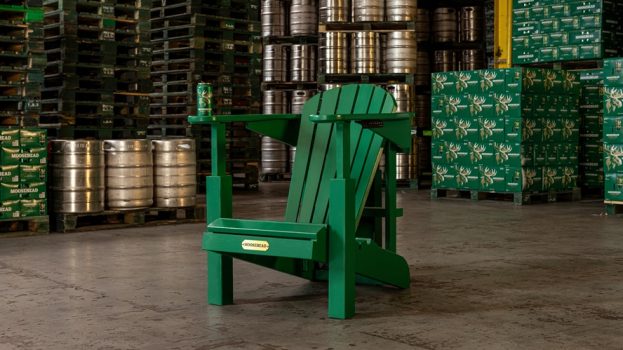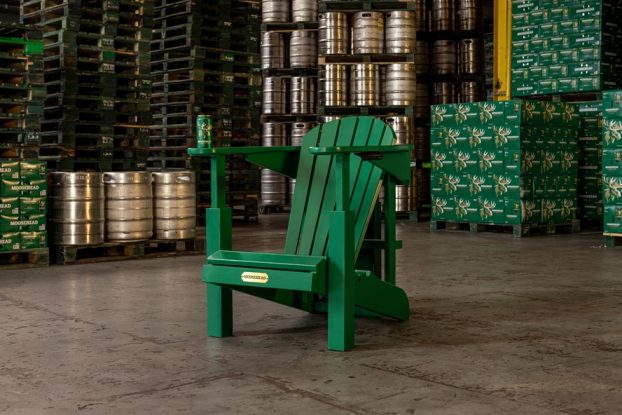 Just a few days into 2024, change is in the air. New Year’s resolutions and self-improvement are on everyone’s minds as the calendars shift, so strategy reached out to several marketing professionals to discuss the changes they predict and hope to see this year. (Pictured, left to right and top to bottom) Mondelez Canada head of marketing Chantal Butler; IKEA Canada head of marketing Jonelle Ricketts; Pizza Pizza vice president, marketing Adrian Fuoco; Sporting Life chief marketing officer Frederick Lecoq; and Air Canada vice president, brand Andy Shibata all provided their insight to strategy about where they see Canada’s ad industry moving in 2024.
Just a few days into 2024, change is in the air. New Year’s resolutions and self-improvement are on everyone’s minds as the calendars shift, so strategy reached out to several marketing professionals to discuss the changes they predict and hope to see this year. (Pictured, left to right and top to bottom) Mondelez Canada head of marketing Chantal Butler; IKEA Canada head of marketing Jonelle Ricketts; Pizza Pizza vice president, marketing Adrian Fuoco; Sporting Life chief marketing officer Frederick Lecoq; and Air Canada vice president, brand Andy Shibata all provided their insight to strategy about where they see Canada’s ad industry moving in 2024.
What’s one thing you hope the industry plans to start doing, one thing it needs to stop and one thing you hope it changes in 2024?
Mondelez Canada’s Chantal Butler: I believe 2024 will bring even more innovation in the AI space, and I’m hoping to see brands start leveraging it in new ways. AI is a huge opportunity for marketers across the globe and I see it continuing to be an area of interest in the industry in the upcoming year.
I’m also hoping for a shift towards prioritizing authenticity in brand voices and actions, as it will become increasingly important to consumers over time. The more we can ring true to our brand purposes and meet our consumers where they are, the better.
Pizza Pizza’s Adrian Fuoco: I think we’re already along this path, but speaking from a client perspective, I hope that while we remain guided by insights and strategy we still save plenty of energy for measured risks, and invest in a few “out there” ideas to help our brands grow.
Something to stop? Maybe overthinking. If you’re investing in a major TV production, it’s understandable to overthink a little, but so many amazing ads today are creator-driven short format developed by and for their audiences. It takes courage, but sometimes you need to step back and let them do their thing if you want it to work.
Sporting Life’s Frederick Lecoq: Start doing: embrace the generative AI revolution and expand its usage beyond content generation to new areas such as personalization and ad planning. Two decades ago, digital disrupted our marketing playbook, and the same thing is happening now with AI, and a “wait and see attitude” is not an option.
Stop doing: buying impressions and focusing on share of voice. Instead, we need to leverage new marketing technologies and earn share of mind through content relevancy and always on conversation.
Change: The marketing proofing process needs to become more agile in an environment where quick response to change is needed. The waterfall approach for decision making is obsolete.
IKEA Canada’s Jonelle Ricketts: Although I’m still re-familiarizing myself with the Canadian industry after living and working in the Netherlands for four years, I have tried to stay close to how the industry has been evolving. My biggest hope is that the industry becomes more intentional and action-oriented about creating a more inclusive environment for under-represented groups. I would also like to see more commitment to building a pipeline of more diverse talent that truly reflects Canadian communities.
As the first in my family to be born in Canada, my parents always encouraged me to go after my dreams and told me that I was capable of doing anything. From a young age, I knew I wanted to work in the world of marketing. Unfortunately, I didn’t see much representation, so I wasn’t sure what types of opportunities would be available for me. I’ve now worked in this industry for more than 20 years and although I’ve seen positive movement, there is still a long journey ahead. I’ve sat in countless boardrooms where I’ve been the only one in the room who looked like me. Like many other young marketing professionals from under-represented communities, I didn’t have role models to look up to or a network to rely on. For me, representation equals possibilities. It creates the ability to dream for more for yourself.
I know many in the industry have responded to calls for equity in the past few years to create justice and inclusion in the industry for Black, Indigenous and People of Colour professionals, but it feels like much of that momentum (and accountability) has slowed down. We need to re-commit ourselves to the work. I know it can be daunting and it’s hard to understand what your small actions can do, but this is a movement that requires a village. We all need to do our part and find ways to set aside differences and work together towards this common goal.
We need to stop jumping on every new trend or shiny new thing. I believe in exploring new innovations and being intentional about setting aside budget to test and try new types of content, ad formats and technologies. But I also believe that it’s important to not forget about the content and media channels that have been proven to work hard and deliver results. It’s often a little less “sexy” to the industry and isn’t the type of work that gets people talking or winning awards, but it’s the heartbeat of your business, with proven ROI that you can’t walk away from.
I hope the industry approaches 2024 with more empathy for Canadian consumers truly looking to understand their current reality. It’s important to understand what consumers care about and to take a critical look at data and insights to understand this and then act on it. We need to look beyond our circle of friends and colleagues to avoid making sweeping statements about the Canadian reality. With changing demographics across Canada, it’s more important than ever to take the time to understand this. What you think you know about Canadian consumers from five years ago looks very different today and it continues to evolve. Being curious and open to different perspectives is key.
Air Canada’s Andy Shibata: Last year, you’d have been hard pressed to find a marketer anywhere who wouldn’t acknowledge the emergence of AI into mainstream conversations. As marketers, we went from hardly talking about AI to discussing it daily with our partners in the business.
Much like social media made a publisher out of everyone, AI is allowing smaller teams to “scale” and compete with bigger teams and budgets, creating interesting shifts in power dynamics across industries. In 2024, we need to start asking how we use AI to not only differentiate and boost ROI, but also drive deeper customer connections. With so much focus on the artificial, to stand out in 2024, I think brands will need to go all-in on what’s true and authentic to their customers.
Right now, everyone is kind of at the same level as they experiment and implement AI in their organizations. In 2024, we’ll see the brands that understand AI separate from the pack, and there will be clear winners and losers at the end. The winners will create more experiences that connect emotionally with their customers and capture the essence of their brands.
What do you see as the biggest challenge facing your work/business? How are you planning to address it this year?
Butler: We successfully navigated the first full year post-pandemic in Canada, culminating in a landscape where adapting to changing norms became crucial. While we gradually went back to normal — with partial office returns and schools resuming regular schedules —inflation soared to an all-time high, significantly impacting spending trends among Canadians.
For the year to come, we are more optimistic for inflation that is more in line with historical trends, and in-home consumption will continue to be strong. In addition to inflation, the pandemic also accelerated online habits. Consumers’ willingness to shop online has continued to increase, and as a result, marketers have to redefine how to reach consumers in this increasingly digital world. Looking ahead to 2024, this will only continue to accelerate, and creating relevant content that connects with consumers on their platform of choice is key to winning in the digital space.
Fuoco: The biggest challenge we’re still facing is high input costs being passed onto our customers. Everything feels expensive, so the way to address it is to continue to develop products people need that deliver real value for money and then advertise the hell out of them.
LeCoq: The mass personalization journey we’re on, has us facing two main challenges: how can we mass produce content at scale and quickly, and how to keep our data clean and fresh.
It is a complex problem to solve, but in my opinion, the combination of people and process will be the winning formula. Some of the ways we’re addressing this challenge are partnering with HR to raise the culture and capability around the topic (our new way of marketing lies in content, data and connectivity), creating new positions in the org structure to ensure some resources are in charge of these new value domains (content scheduler, data team), becoming the “CTO’s best friend” to design and implement the proper “martech” infrastructure, and providing guidelines to the team through governance and process documentation.
Ricketts: Like many retailers, one of our biggest challenges is related to the current economic climate. Consumers are being much more careful with the money they have to spend and need to focus on securing their basic needs. We’re all facing this reality on a personal level as consumers – our dollar doesn’t go as far as it used to and our wallets are much thinner. Canadians are looking for affordable products and solutions, but also don’t want to compromise on quality.
How we address this challenge ultimately comes down to our vision – to create a better everyday life for the many people. Part of creating a better everyday life right now also means providing Canadian consumers with affordable home furnishings. We are continuously innovating and making improvements across our value chain to lower our prices, without compromising on quality – ultimately passing these savings along to consumers. We will continue to make bold moves in 2024 to lower prices on many of our products and become even more affordable for Canadians.
Shibata: Canadians are still living through considerable uncertainty. People are less focused on “what’s next,” and are looking for more reassurance and trust from global brands. Driving deeper customer connections will be an important evolution. With time free to explore, listen and learn, the smart approach will be in exploring the facets of “human” connections.
This means keeping a strong focus on what matters most to your customers and what drives value, like heightened care in every interaction, better execution and more engaging storytelling. It also means recognizing that standing out requires connecting with people in exciting and authentic ways that still align with their expectations of your brand.
For example, at Air Canada, we will be increasing transparency through innovations that help us deliver greater hospitality for customers both on-ground and in-flight. The more we can personalize our interactions with consumers, the more we can put them in the pilot’s seat to shape those moments in ways that suit them best – that’s a big change in the relationship between marketers and consumers that I think we’re going to see a lot more of over the next year.























